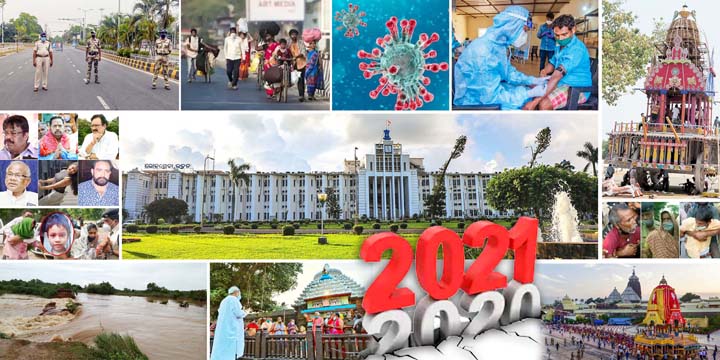Everybody in Odisha and India would not like to remember the life-time experience they had in the past 300 days.
It was mostly a year “never before”.
This is the sentence uttered by one and all, from poor to rich and from children to elderly persons. Even the centurions say 2020 was a “never before’ year.
The dangerous virus emanating from China changed the situation in the globe. The pandemic forced everyone — from Prime Minister to the one on streets– to cover faces.
Never before, schools remained closed for months together or the children in rural pockets climbed the trees and hills to get online education.
Lord Jagannath’s Ratha Jatra and Chandan Jatra were held without devotees while major festivals such as Ashokastami of Lord Lingaraj were cancelled.
Odias, who never missed ‘Darshan’ of the Lord at least once a year, were forced to pay obeisance to their beloved deities on television screens—a ‘never before’ again.
The pandemic affected all walks of life. All the sectors remained dormant for months only raising their heads towards the year end.
However, detection of a new strain of coronavirus in the United Kingdom again forced the administration to tighten the restrictions.
Chief Minister Naveen Patnaik, who normally attended office every day at 11 am, operated on virtual mode. The State Assembly sessions were held under strict COVID-19 guidelines and lawmakers were forced to address with masks on. It took months to get used to make movement in a graded manner- even on the last day of the year.
Odisha politics, witnessed a shift this year as Chief Minister and ruling BJD President Naveen Patnaik backing his old formula of “equal distance” from both the BJP and Congress.
The people of the State witnessed BJP veteran Amit Shah having lunch with Mamata Benerjee, Nitish Kumar, Dharmendra Pradhan at Naveen Niwas.
The message was clear and there should be no doubt over the strong friendship between the ruling BJD and opposition BJP in Odisha.
The honeymoon between the two former allies, however, did not last long as Naveen has started calling national parties as enemies of the state like Odisha which has its own identity. Though not in clear terms, Naveen has given clear message that BJP was not suitable for the interest of Odisha and called upon people to back the regional outfit to fulfill aspirations of the state.
Naveen and his party by the end of 2020, is back to the fight as the saffron party too intensified its outreach programs. Both BJP and Congress have also appointed their new state in-charges while Naveen reorganized his party for big fights in days ahead.
The outgoing year witnessed a new format in the BJD when Naveen expelled his one-time close aide Pradeep Panigrahi on charge of “anti-people” activities.
The State also witnessed a different kind of electioneering when the people cast their votes in two by-elections in Balasore and Trirtol. The ruling BJD won in both the seats.
Towards the end of 2020, Naveen allowed Chief Secretary Asit Kumar Tripathy to retire and assigned him the top post of Western Odisha Development Council with Cabinet Minister status and the charge of Principal Advisor to Chief Minister.
Apart from COVID-19 pandemic, the State also had unwanted guests like cyclones, floods.
The pandemic posed a bigger challenge for putting in place effective governance, robust health infrastructure, mass testing, efficient handling of migrant workers, including screening and quarantine, involvement of women self-help groups and Mission Shakti to face the situation.
When the first COVID-19 case was reported on March 15, the State’s control rooms were already functional, while capacity building, awareness campaigns about hygiene, hand washing, sanitization, social distancing, use of face masks and respiratory etiquette were also in place in Odisha.
Odisha was among the few states to have created dedicated COVID-19 hospitals in every district in record time. It also set up an inter-departmental task force to oversee and monitor the pandemic management.
Naveen unveiled a Rs 17,000-crore plan to support the livelihood of people, including farmers and migrant workers, hit hard by the economic crisis triggered by the pandemic.
Even as the pandemic prevailed, an unwanted guest- the super cyclone Amphan- on its way to West Bengal, left a trail of destruction in Kendrapara, Jagatsinghpur, Bhadrak and Balasore.
The state also encountered a flood-like situation, owing to heavy downpour triggered by a series of low pressure areas over the Bay of Bengal.
It was a year with maximum number of low pressures — “never before.”


